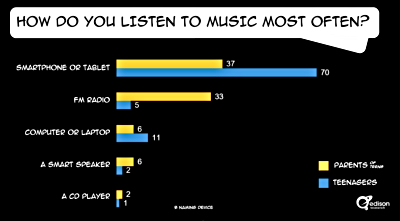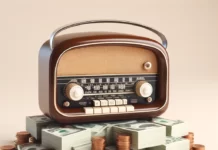
That could change if the industry as a whole stops ignoring the demo that’s playing a big role in how their parents listen to music. Edison Research made a presentation at the Country Radio Seminar, Thursday, that should have every program director, manager, and owner very concerned.
“Spotify changed my life.” That was a quote from a parent in the 25-54 “money” demo in the Edison presentation. At first the parent was reluctant to listen to her teenager who was pushing Spotify. However, when she gave in, she agreed. Spotify was a whole new musical world for her.
And that was the theme for the entire presentation.
Teens are having more of an influence on how their parents listen to music than ever before. And as Edison Research President pointed out, the Spotifys, Pandoras, and SiriusXMs of the digital audio world have absolutely no connection to the local community, and that is most concerning. They simply don’t care about radio’s number one strength.
Over half of the nearly 2,000 parents in the Edison Research study say their kids have 
made it easier for them to use music apps. Teens are pulling their parents toward streaming music apps and away from their established habits. Edison’s Megan Lazovick said, “Radio needs to educate teens and give them the content that they want.”

made it easier for them to use music apps. Teens are pulling their parents toward streaming music apps and away from their established habits. Edison’s Megan Lazovick said, “Radio needs to educate teens and give them the content that they want.”
When teens were asked to explain what FM radio is, here were some of their responses:
– Why would I sit through a ton of ads? The music I like is on my phone.
– I never listen. I plug in my phone to listen to my own music.
– Why would I listen to a song I don’t want to listen to? I have Spotify.
– FM radio is for people “your age.”
The fact is it’s getting easier and easier to listen to music on smartphones, even in the automobile. These kids have basically grown up with cell phones in their hands. And, parents often turn to the younger generation to understand the technology. So it should come as no surprise that kids are influencing their parents more when it comes to music listening, especially when parents are always looking for ways to bond with their kids when they are teens.
Many in the radio industry believe that teens grow up, become adults, enter the 25-54 demo, and turn to radio as working adults. With the amount of time they spend on devices from the time they are able, you have to ask yourself, do you really believe that will happen with this generation of teens?









Very efficiently written information. It will be beneficial to anybody who utilizes it, including me. Keep up the good work. For sure I will check out more posts.
I really like your article. Looking forward to reading more. Keep writing!
Great post, you have pointed out some fantastic points , I likewise think this’s a very wonderful website.
Gee, who knew!?! Oh…just the entire industry. This shouldn’t be a surprise to anyone – especially owners – and I bet these tired stats I keep hearing about radio’s weekly reach are less than half of what’s being promoted. Radio is where the newspaper biz was 10 years ago. In its current form, it has become a dying business. It’s really pretty obvious, isn’t it?
Breaking news: Teens don’t like listening to boring, canned, unoriginal, dull radio. We knew that in the 1970s…so we tried not to do it THEN.
So instead they listen to boring, canned, unoriginal dull streaming. Much better. Lots of live & local DJs on Spotify.
Compelling radio always wins! If there is talent and chatter – teens will check it out! Juke Box/VT radio is done cheaply and gets cheap results!
After reading ALL the comments ALL the way through.. this is for Kevin Neathery, Reynolds Radio, Tyler/Longview TX… YOU are the man. Don’t let anyone stop you from believing and preaching the message. Keep the passion. Do Not listen to naysayers. You GO man!
To be sure, Kevin. Not a novel idea.
Still, the challenge remains: What jocks? With what training? From where? Trained and monitored by whom?
The radio we remember had guys lined up around the block to get a shot on the air.
The task of getting back to anything as raucous as we recall might be more than formidable.
Not my idea. Not my concept. Not my imagination.
Just a return to what made radio great in the first place.
Hit radio stations! Bring back the night jock! Live, local, talented and guided by today’s radio veterans who remember exactly what to do and how to do it. Dump the voice track. Ditch syndication. Quit depriving our future listeners, draining our talent pool and blaming it on smartphones and digital audio platforms. Is this where we are?
I went to high school with rock n’ roll and KMET. Jim Ladd was a night time deity. In a Volkswagen van, “Thank You” by Led Zeppelin fading out, Jim’s segue: no words, but, a lung buster toke, silence.
Give our teens their own soundtrack like we enjoyed back in the day and they will never leave us.
BINGO! I have been echoing what Kevin has stated for years! I spent years on the air at CHR stations and I listen to them now and they are boring! People can get their music anywhere, it’s time to put talent back on the air! It’s time to INVEST in your staff instead of bleeding your station dry for corporate profits today! Currently I am teaching young radio talent at the college level. One can find air checks from talented broadcasters all over the Internet and even on Youtube to support training up our future broadcasters. I have dozens of alumni who work in the field and I bring someone in every semester to talk to them.
Another advantage radio has is being local. Push what is occurring in your community that your demos care about. You can’t win concert tickets to the hottest act appearing next week in your city on Spotify. You can give away back stage passes, have live studio interviews and have the artist give away tickets to their show, etc. Hell, bring a superstar to town and have a live autograph session and tie the appearance in to a local advertiser! Think out of the box! Giveaway autographed albums! Yes records are back! Give away tickets and bring in the next up and coming superstar to a small local venue and make it exclusive to your station. Radio used to think out of the box to steal listeners from competitors!
Bring back commercial free hours and promote them big time. Lower the amount of spots in your stop sets. Give away money and place the contests even in the middle of your stop sets. Give them more reasons to listen. The corporate suit that figures this out will be the next trendsetters, but they will need to INVEST in their stations.
Take advantage of the Alexa. I don’t see anyone purchasing radios for their homes, but they are buying Amazon’s Echo. How many ID’s has your station created tied to this. ” Alexa turn on WXXX.” How much of your air talent is interacting with social media. Have fun with Facebook live! I could go on and on….
Teens are trouble for radio? Nah. I remember when corporates become trouble for radio and only getting worse. I’ll have to confess I only skimmed this story as it’s long winded. It’s not just ads kids don’t wanna hear. It’s also having the choice to choose what they want to hear. As a man in the biz 25 years, I have a huge appreciation for broadcast radio. So much I have a house full of collected equipment I got, repaired and play with. The magic of radio. Those late nights as a kid having my favorite jock take me through a scary thunderstorm. Well kids today don’t know that magic since they have everything they need on a phone. Most don’t even know what a stereo with large speakers sound like. For kids to be trained in radio someone would have to first allow them to come in. Who will? The one reason there are radio pirates is because they cannot get access to the stations owned by the corporates. I been a broadcaster close to 3 decades and even I cannot easily walk in for a job like the old days. I know across the country there are a very few non profit stations somehow put together and licensed that allow volunteers. But it’s certainly not common everywhere. Kids interested in getting into broadcast FM enough generally end up buying a transmitter and starting their own little underground hobby station. The path of least resistance. Even today myself I pull out an exciter, one of my processors, connect to my rebuilt autogram console, and spin some cds.
Kevin’s idea about having “live”, young jocks at night is, I believe a stellar one.
However, executing such a strategy is formidable.
If the outcome is to be exceptionally appealing to a younger demographic, a number of factors will have to be addressed.
From where will these untrained performers be drawn?
How many local PD’s are equipped and capable of doing the training.
There was a time when all of us had models (other jocks) from which to gather and experiment with our own chops – up and down the dial. And because we were AM, we could hear from great performers in at least half a dozen Major markets. Excellent schoolin’, indeed.
How many of these local PD’s are even willing to spend their evenings monitoring the new meat?
Will the talent be continuously abused and terrified of the equivalent of “The Bat Phone” going off during their shifts.
Will ownership allow the new, presumably unskilled talent to get down and participate on the air longer and more often?
Will ownership dispense with the phustercluck of spots? (They are, after all, audience killers.)
As much as I cheer Kevin’s concept and imagination, I have to wonder: What are the chances?
You want to train these up and comers right? Get rid of the “prep” sheets. They are nothing but a crutch. They teach you nothing. If not you’ll have nothing but different varieties (so) on the air.
I meant different varieties of John Tesh on the air
This is a great example of two people going to the exact same panel, and hearing two completely different things. Here is in fact what the Edison report said about teen listening:
“According to EDISON’s industry-leading “Share Of Ear” study, AM/FM radio remains the top platform for teens, with 63% of 13-19-year-olds listening to radio every day.”
Why was that not reported in this story? Not even mentioned. Yes kids love Spotify. They also pay for Spotify, and they don’t pay for radio. If people paid for AM/FM, they’d get what they want. Perhaps that’s the model we should follow, and let go of ad-supported radio.
From here:
Because of the huge number of 12-24 listeners available at the time, radio was broken down to a few formats – Top 40 and some form of MOR. News/Talk/Music was, essentially, MOR and slid in there, as well.
What happened and to nobody’s surprise, is that Top-40 refused to grow with its audience – even while the bell was tolling. FM saved their bacon.
Music Radio has also locked itself out of trying to appeal to ANY demographic or psychographic opportunities INCLUDING the ones they claim to already serve.
The Mandarins are not bright people.
Perhaps The Trumpster is one of their heros. This would explain a great deal.
LIVE, LOCAL and YOUNG at night!
The key to growing cume among teens on hit radio stations is a simple fix: THE NIGHT JOCK! He or she must be LIVE, LOCAL and YOUNG! I mean really live and local. No voice track. This sounds obvious, but let me be clear. He or she has to be a real person, a local resident at the station 7p-12 Mid Monday through Friday.
And young with a youthful voice not heard on any other shift on any other station. And the show must be steered by the PD. That means listened to by the PD every night and on the phone in an instant to praise, coach, scold, yell, cuss or worse.
Teens want a smoking hot, fast paced show with lots of phones and cool bits involving teens at local places with local voices all over the air. This means station management has to add to payroll and monitor activity and the inevitable night jock shenanigans: “Visitors” to the studio, playlist violations “It was a request,” dead air while night jock meets pizza delivery man to trade station swag for free dinner, all the price to be paid to capture and retain teen listenership.
I don’t agree spot loads are to blame, teens will listen all night if the night jock is talented, plays the hits and engages the audience with cool content we oldsters can’t relate to any more. That’s the point.
The added benefit is recruitment! Many if not most of today’s Air Personalities, were originally drawn to radio with the desire to be “that jock.” The cool night jock, popular, famous, funny, witty, cool, babe/dude magnet. That’s what attracts fresh new talent to our industry. And way back when, voice tracking wasn’t an option. You had to “tolerate talent.” Sadly, today’s owner’s don’t have to tolerate talent. The night jock isn’t really at the station and our teenagers know it.
It’s an easy fix and if you are a locally owned hit station, a sure bet to grow your teen audience!
You are in denial, like many in radio at all levels, when you say that you don’t believe that spot loads are a problem. The participants in this Edison Survey said that is EXACTLY the problem– that they will not listen to a ton of ads!! This sadly is the major cancer to radio today– many owners, top managers and field soldiers live in complete denial of reality. Reality 1 is there are way too many commercials, plus the long breaks have driven listeners away (and shafted the advertisers who are buried deep in the cluster breaks, when many listeners have already tuned out en masse). Reality 2 is that $12 or $15 night shift or weekend announcers are not compelling personalities, not at that pay scale which is prevalent at many stations now. Reality 3 is that many stations have cut both promotional and news budgets…so involvement with the “local community” for many stations is highly marginal, at best. Again, many owners especially the corporate owners are in just a short-term money grab with their stations, and do not believe in investing in the medium for the long term.
Again, it depends on the company for which you work. Not every is running 9 and 10 minute stop sets. Some are as low as 5 or 6. Me? I’d like to see the number of sets increase to 3 an hour with fewer units…but I don’t run the radio world.
I guess I’m just as bad. I only listen to out of market OTA stations on the stream. Why listen to boring radio here when stations like 92 Moose in Maine and HitFM in the Ukraine play better songs. In the morning I listen to WMT news/talk in Iowa because those guys are entertaining.
I have to admit I heart knows how to do news/talk.
Let’s all just pretend this isn’t happening. Just like we have for the past 20 years.
Many radio station top corporate “leaders” (not really;more like monarchs) and owners have their heads completely in the sand about this. Teens, and many adults, say exactly what this study says: “Why should i listen to radio and be subjected to a ton of ads?” …The aforementioned corporate types and owners remain tone deaf on this. They refuse to reduce the absurdly-long commercial loads and the intolerably long commercial clusters, because it is now all about making the revenue for the quarter, with zero long-term investment or strategy. This myopic thinking (or lack thereof) is killing the business. And to think that teens will magically “come to radio” when they grow up, is like dreaming that they will start picking up newspapers.
yes…we all grow up, settle down (plant our feet) and start to care about how the (for example) changes in zoning, new taxes, new levy, new sheriff, new mayor, new hospital affect their lives and pocket book…they will only get that information from local media…local!
true story, but nobody said that radio is the only local media. All of that ‘local info’ is available on the phone as well.
Anything you can put on a radio station can be found on the internet within seconds. That you haven’t learned this yet, SMiller, speaks volumes about the continued degeneration of radio’s relativity.
I wrote this Nov. 9, 2000: Then, there are ‘Sellphone’ ads – using GPS – that target your walk down the street. The market is set to explode to $750 million by 2005… so be warned, wireless [cellphone] ads are coming to either entice you to buy or steal away your clients.
“Everything is fine because we’re local” has been the call of radio executives for over two decades. They were wrong.